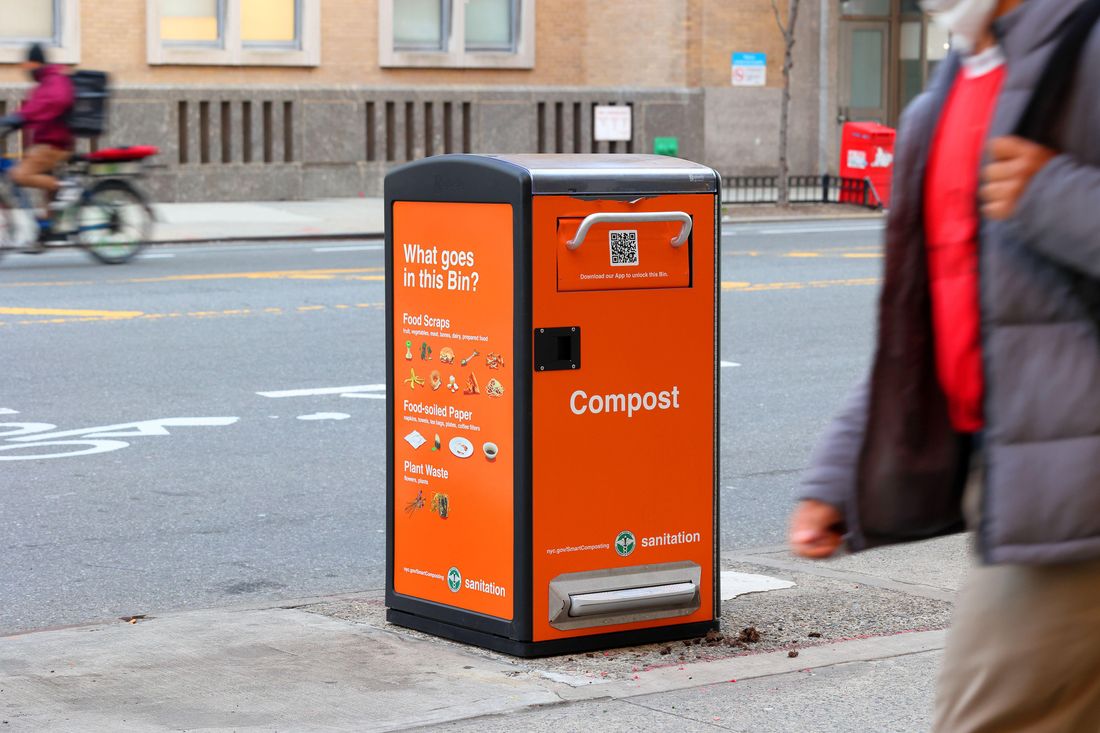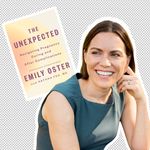
New York City has been big on bins lately. The Department of Sanitation piloted locked communal receptacles in Brooklyn and Manhattan and is paying McKinsey $4 million to study how the city might adopt a containerization program like those in Paris or Barcelona. There’s also some new street furniture on the block: the bright-orange Smart Bin with “Compost” emblazoned on the front and illustrations of banana peels, coffee filters, and wilted flowers on the side. Their most striking design feature, though, is forcing people to be intentional about what they throw out. Try to mindlessly ditch a coffee cup in a Smart Bin and you’ll find yourself shut out. Access requires some intent: a QR code on the front of each container leads to a download of the NYC Compost app, which can unlock any of the 250 bins that are currently stationed around the city. Then, say goodbye to your eggshells.
This extra step is an effort to prevent contamination — or when non-compostable materials wind up with organics in the containers. (The issue of mixed materials became such a problem for the street recycling program that DSNY removed many of those bins entirely.) When it comes to the Smart Bin, the agency believes that the app offers just the right amount of friction. “We want the bins to be simple enough so that people passing it on the street look at it and immediately know what it is,” says sanitation commissioner Jessica Tisch. The city also, crucially, wants this piece of its composting program to succeed, and that means keeping busted umbrellas and the errant tall boy out of the bins.
It seems like a lot of effort to keep an apple core out of the trash, but the Department of Sanitation believes these Smart Composting Bins are essential to cutting down the staggering amount of waste that New Yorkers send to landfills — about 14 million tons each year. The problem, as DSNY sees it, is that composting is simply too much of a hassle right now. “The Smart Bins are part of the city’s layered approach to composting services,” says Tisch. If using a New Yorker’s limited counter and freezer space to store compost is a barrier to doing it, then a place to ditch last night’s carrot peels on the block could help. DSNY is also betting that the user-friendly experience it offers with Smart Bins will entice more New Yorkers to compost, just like good design enabled Apple to sell glass bricks to billions of people. But will it work?
Over the past few years, DSNY has adopted what it describes as a customer-centric approach to its work, which includes a surprisingly charming TikTok and redesigning its public-facing elements, such as bins. Every element of the Smart Composting Bins is tailored to be a “mass-market service,” says Tisch. The color and graphics are intended to be eye-catching and easy to understand — simple and uncluttered. It’s a much more streamlined approach than the version of the Smart Bins installed during the Astoria and Lower Manhattan pilots in 2022. Gone are the cheeky taglines (“This Is Not a Trash Bin!” and “Make Compost, Not Trash”) and the detailed—some might argue confusing—instructions on how to use them. Instead, the Smart Bins only announce what should go inside with the question: “What goes in this bin?” DSNY also replaced the lipped door that was hard to clean and also too narrow for some users with one that fully rolls open in an instant.
The most consequential change from the pilot, however, is the required use of a smartphone app to access the bins. DSNY views this as an improvement over the key fob that was required back then, which involved a signup and waiting for the key to arrive — an obvious headache that would discourage mass composting. The app itself is streamlined: As soon as you open it, you’re met with a map of the Smart Bins. There’s no need to register or enter any personal information. Once you get close enough to a bin to open it, an “Unlock Bin” button on the screen turns green. DSNY says app downloads are growing about 54 percent each week and the number of times the bins have been unlocked is growing 25 percent weekly. To date, the bins have been opened 75,000 times.
But it’s still an app, and an added step to a process that already has limited buy-in across the city. And there are still New Yorkers without smartphones, of course. Tisch says she still sees it as the best option: “If you could easily use an app on your phone and reliably open the bin without too much drama, that to me is not a barrier to entry.” For anyone who finds the bins to be too much of a hassle, she adds, “there are hundreds of compost drop-off sites around the city in every community district.”
“It’s a terrific program for Sierra Club members or people who’ve taken environmental studies,” says Eric Goldstein, a senior attorney at the Natural Resources Defense Council who advocates for solid-waste reform in New York City, with skepticism. He’s right. The already converted are the bins’ early adopters. But for those who don’t already compost, the bins are mostly a mystery. (A couple weeks ago, while I deposited some compost in a bin, two people nearby asked, “Do you have to pay to use that?”) Which means that while the Smart Bin may be user-friendly, its user base may still be incredibly narrow.
So how do you entice people to schlep their food scraps to bins down the block? Longtime composters all say maintaining uninterrupted service and frequently conducting education and outreach is essential — two things that DSNY has had trouble with in the past. Pamela Tuffley, a compost coordinator at the Prospect Heights Community Farm, remarked that the rollout felt similar to a curbside composting pilot in Sunset Park, where she used to live. Brown bins suddenly appeared one day, but weren’t widely used because “there was no sort of education and no sort of culture change.” DSNY says it has spoken at community board meetings in every district with a Smart Bin, handed out flyers at neighborhood events, and will continue to do outreach. The agency also believes the bins are designed to be billboards for themselves, but it’s unclear, at least at this stage, if it’s right about that.
Still, the bins represent an optimistic view of the future in which composting is as routine as taking out the trash and viewed as an essential service. “If we’re to achieve the environmental objectives of composting and for it to be economically efficient, we need participation across the board,” NRDC’s Eric Goldstein says. (Adams says curbside composting will come to every city neighborhood by 2024, though your mileage may vary on how much you believe that.) For now, we’re left with the hodgepodge of drop-offs at green markets and community gardens, limited curbside service, and the newly minted Smart Bin. People are curious about them, at least. A school crossing guard stationed near a Smart Bin in Crown Heights told me that she had seen a steady stream of people depositing their compost. And while she hadn’t personally used the service, she said she would if there was a bin installed closer to home. The city intends to roll out a total of 400 by summer, so it’s quite possible she’ll get one. Hopefully she’ll download the app, too.




